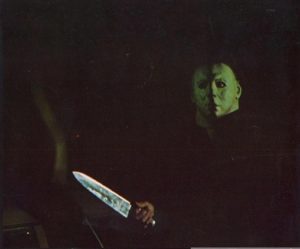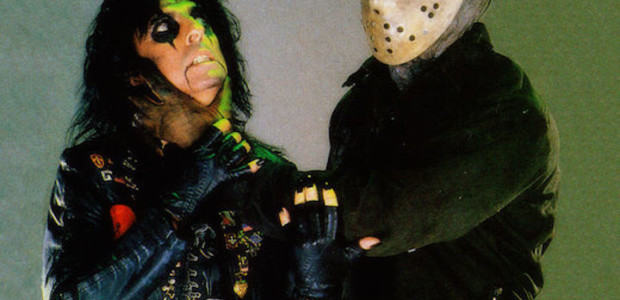Horror films have long held a special relationship with film scores. From the moment F.W. Murnau premiered NOSFERATU in 1922 with a live score by Hans Erdmann, a powerful, unholy alliance was made. Just like Ghostface and Sidney, or Freddy and Nancy, the entwined and complex bond between visual and sonic elements work in tandem to create a unified and visceral cinematic experience. And while all horror films benefit from a good score, the slasher has evolved its sound in its own unique and beneficial way.
To fully appreciate the slasher’s utilization of sound at its best, it’s important to understand where it began. And when it comes to this particular idea, two films kicked things off in 1960; Michael Powell’s PEEPING TOM and Alfred Hitchcock’s PSYCHO. In PEEPING TOM, Powell crafts an effective film far ahead of its time. Along with its famous implementation of POV shots, each kill is accompanied by a whirring camera sound effect. Quickly, an association develops between the sound and an imminent on-screen death. United in dark motivation, one implies the other, heightening the tension and viewer engagement.
With PSYCHO, one cannot understate the impact of Bernard Herrmann. An incredibly influential composer, Herrmann’s work forever changed the way horror films were scored with his brilliant use of stringed instruments. Using a stripped-down orchestra, Herrmann transformed the beautiful violin into something terrifying. Mimicking the knife’s movements during the iconic shower scene, the slashing, screeching violin sound adds layers of emotional cues that then become sprinkled throughout the rest of the film. Establishing precedent, Herrmann’s technique of auditory weapon mimicry quickly becomes another piece in the slasher sound puzzle.

Further developing and playing off this idea comes Dario Argento’s DEEP RED. With music always an important focus for the Italian director, it makes sense that he would utilize the medium in such a principal way. Preceding the film’s kills, a recording of a children’s song plays, announcing the killer’s presence to both characters and audience alike. Although the killer’s identity remains a mystery until the end, the kitschy melody comes to symbolize their presence and intent while simultaneously terrorizing the victims with auditory mind games. Tied to the killer’s motivation, this usage of music as a foreshadowing signal laid important groundwork for the genre.
As the musical genre continued to grow in popularity and prevalence, many films would continue to play with the idea of triggering musical cues, themes, and instrumentation for their killers. While some dipped a toe into crafting a sound, others jumped all in and changed the slasher sound forever, especially 1978’s HALLOWEEN and 1980’s FRIDAY THE 13TH.
For HALLOWEEN, John Carpenter tackled the score for one simple reason—he was cheap and fast. Familiar with the process after scoring his first two films, Carpenter knew exactly what the film needed while adopting the idea that sometimes, less is more. Tapping his tech-savvy friend Dan Wyman for support, the two pulled together an array of electronic instruments that could be operated using minimal man-power, but still provide a cinematic feel. Embracing the technology of the time, this stripped-down sonic foundation established a whole new type of horror villain and score.
Shrouded in mystery, coveralls, and a literal mask, HALLOWEEN’s Michael Myers is a character with a strong, unsettling visual impact. But he doesn’t reveal much more than that. There is no dialogue or facial movements to formulate a personality or imply emotion. Even his body language is controlled and deliberate, offering nothing extra in the way of inner identity. Although this conscious lack of personality adds weight to his actions, he needed something more to connect with viewers and systematically build tension. This is where Carpenter’s score comes into play.

Seemingly simple, there are layers of complexity residing within HALLOWEEN’s music. For one, the choice to utilize electronic instruments subconsciously imbues inhumanity to the soundscape. While acoustic instruments like piano, cello, or flute retain a grounded and human element, synths are literally in a world of their own. Fueled by signals, circuits, and electricity, this instrumentation choice casts a cloud of unease over Haddonfield while emphasizing Loomis’ claims that Michael is indeed evil and not entirely human.
Another layer of subconscious music theory working to Michael’s advantage strikes in the famous theme song. Snatching attention with its repetitive, piercing piano melody and catchy 5/4 time, the shifting diminished 5th to minor 6th interval feels unsettling for good reason. Also known as a tritone or the devil’s interval, the interval leads neither up nor down and historically, was even banned from church use. This subconscious anxiety then gets coupled with octaves in the lower range. Providing sonic stability that resonates with significance, the pairing effectively fires on all emotional cylinders conveying tension and darkness with ease.
Executed perfectly, the theme becomes consistently tied to Michael’s on-screen presence. Instantly recognizable and coupled with sting cues, the melody conveys narrative intent while heightening apprehension. Acting as a form of radar, these uniform auditory cues signal Michael’s presence and send us searching for his lurking shape. This unprecedented sensory experience adds powerful depth to his persona while creating an enduring, symbiotic relationship resulting in one forever implying the other.
Nipping at the heels of HALLOWEEN came Sean S. Cunningham’s FRIDAY THE 13TH. After a famously disastrous test screening without music, a strong score was not just a good idea, but a crucial one. Calling on composer Harry Manfredini, the duo cultivated a score that called on films from the past, while retaining its unique special flavor. Embracing a more traditional feel in terms of instrumentation, Manfredini’s PSYCHO and JAWS inspired use of strings blends seamlessly with restrained electronic elements. Creating a truly unique cue with its infamous ‘Ki-Ki-Ki Ma-Ma-Ma’ vocalizations, the combination of sonic sounds fits not only the film’s camp setting but the killer as well. Providing a conscious human connection with the use of these echoey, subtext laden vocals, FRIDAY THE 13TH’s killer retains an important level of humanity.

Although sound was used similarly in HALLOWEEN, the presentation of FRIDAY THE 13TH’s antagonist is quite different. More in line with BLACK CHRISTMAS, their identity is obfuscated for most of the film. Due to this, the only real identifying aspect to cling onto becomes the score. Utilized often with precision and deliberate intent, the theme’s sonic presence signals that someone is watching the unfortunate campers while cleverly retaining the ability to shift a scene from innocuous to dangerous at the drop of a hat. Even with recontextualized music that was reassigned in subsequent installments, the strong thematic material remained structurally intact and has had a long-lasting positive impact on the franchise’s enduring legacy and popularity.
For these reasons and more, HALLOWEEN and FRIDAY THE 13TH stand strong as pillars of the slasher genre. With their unique and symbiotic relationship between sound and character, the fusion adds a persona, weight, and presence to their otherwise silent antagonists. Instantly conjuring images of masks, kills, and overall mood with a few simple notes, the unification of sound and killer is irreversible. Sending ripples through the genre, films like A NIGHTMARE ON ELM STREET, MY BLOODY VALENTINE, CANDYMAN, and SLUMBER PARTY MASSACRE embraced the idea while many missed the memo (and opportunity).
By learning from past films and using music in such a focused way, both films paid tribute to the genre’s history while setting their own special blend of precedent. Surpassing what fancy masks and clever shots alone could convey, sound quickly became a critical tool in the slasher genre, an extension of the killer themselves. Subconsciously connecting and preying on expectations, this powerful blend of melody and character creates enduring memories and associations that transcend the screen and leave us searching the shadows long after the credits have rolled.


No Comments